Instructions for Side by Side Printing
- Print the notecards
- Fold each page in half along the solid vertical line
- Cut out the notecards by cutting along each horizontal dotted line
- Optional: Glue, tape or staple the ends of each notecard together
A&P Exam 1 Review
front 1 4. Visual inspection of the appearance of the liver and gallbladder
during surgery is associated with which of the following? | back 1 C |
front 2 Microscopic examination of a frozen tissue specimen is an application
of which of the following disciplines? | back 2 A |
front 3 85. The wall of the abdominopelvic cavity is lined by a serous
membrane called the | back 3 B |
front 4 The visceral pleura is | back 4 B |
front 5 The parietal peritoneum is | back 5 C |
front 6 The pleural cavity is the | back 6 D |
front 7 16. Organize the following structural levels of the human body from
simplest to most complex. | back 7 C |
front 8 Which level is the basic unit of life? A. 1 | back 8 A |
front 9 13. Which of the following systems carries necessary compounds like
oxygen and nutrients throughout the body? | back 9 B |
front 10 Which organ system is the location of blood cell production? | back 10 B |
front 11 Which body system would be affected by degeneration of cartilage in
joints? | back 11 D |
front 12 19. The gallbladder, liver, and stomach are all part of the | back 12 E |
front 13 What system removes nitrogenous waste products from the blood and
regulates blood pH, ion balance, and water balance? | back 13 E |
front 14 An investigator who conducts an experiment to determine how changes
in pH affect the function of enzymes on digestion is most likely to be
a(n) | back 14 D |
front 15 10. The study of tissues is | back 15 B |
front 16 The study of the structural features and functions of the cell is
| back 16 A |
front 17 Which of the following is consistent with homeostasis? | back 17 A |
front 18 What are examples of homeostatic mechanisms? A. Blood pH | back 18 E |
front 19 Which of the following is most consistent with homeostasis? | back 19 E |
front 20 The anatomical term that means "away from the midline of the
body" is | back 20 D |
front 21 46. The thumb is ___ to the fifth digit (little finger). | back 21 B |
front 22 Medial means | back 22 A |
front 23 55. Proximal means | back 23 D |
front 24 49. A term that means "toward the attached end of a limb"
is | back 24 E |
front 25 The shoulder is _____ to the elbow. | back 25 E |
front 26 43. Which of the following sets of directional terms are most
appropriately referred to as opposites? | back 26 A |
front 27 The study of the microscopic structure of the tissues and organs is
called | back 27 D |
front 28 A bullet enters the left lung and collapses it. Which cavity has been
entered? | back 28 C |
front 29 The membrane on the surface of a lung is called the | back 29 A |
front 30 Which of the following is NOT an example of a homeostatic
mechanism? | back 30 B |
front 31 3. Which of the following activities would represent a physiological
study? | back 31 E |
front 32 83. The suffix "-itis" means inflammation. Which of the
following terms means inflammation of the membrane lining the body
cavity that contains the liver? | back 32 B |
front 33 Tissues are formed by a group of ________ that perform similar
functions. | back 33 A |
front 34 Which of the following lists is in the order of increasing levels of
complexity? | back 34 C |
front 35 To understand the structure of complex body systems we start from the
structure of the atom and progress to the structure of the organ
systems. This concept is called | back 35 D |
front 36 The ankle is _______ to the knee. | back 36 D |
front 37 The carpus is distal to the | back 37 C |
front 38 50. Which of the following is most inferior in location? | back 38 A |
front 39 80. The thoracic cavity is separated from the abdominal cavity by the
| back 39 B |
front 40 82. The cavity of the body immediately inferior to the diaphragm is
the _____ cavity. | back 40 E |
front 41 85. The wall of the abdominopelvic cavity is lined by a serous
membrane called the | back 41 B |
front 42 90. The parietal pericardium is | back 42 E |
front 43 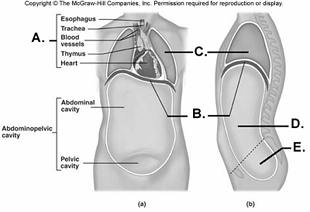 97. Here is a figure showing major trunk cavities and other
structures. What does "A" represent? | back 43 B |
front 44 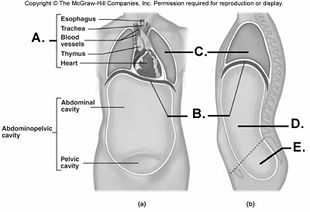 98. Here is a figure showing major trunk cavities and other
structures. What does "B" represent? | back 44 A |
front 45 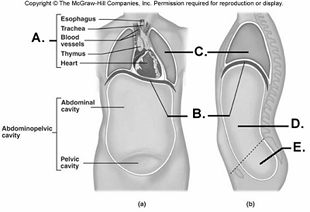 99. Here is a figure showing major trunk cavities and other
structures. What does "C" represent? | back 45 D |
front 46 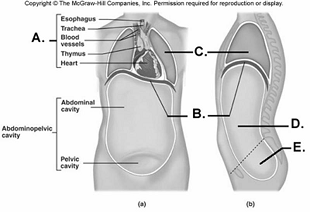 100. Here is a figure showing major trunk cavities and other
structures. What does "D" represent? | back 46 E |
front 47 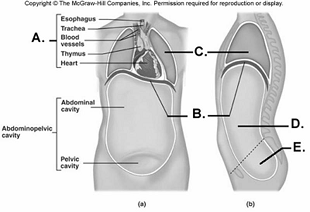 101. Here is a figure showing major trunk cavities and other
structures. What does "E" represent? | back 47 C |
front 48 The cranial cavity is _______ to the thoracic cavity. | back 48 D |
front 49 The dorsal cavity includes which of the following smaller
cavities? | back 49 A |
front 50 Given these organ and cavity combinations: | back 50 B |
front 51 The lungs are | back 51 C |
front 52 A term that means nearer the attached end of a limb is | back 52 D |
front 53 The following events are part of a negative-feedback
mechanism. Choose the arrangement that lists the events in the order they
occur. | back 53 D |
front 54 The urinary system | back 54 B |
front 55 The nervous system | back 55 A |
front 56 The muscular system | back 56 E |
front 57 The lymphatic system | back 57 D |
front 58 The integumentary system | back 58 C |
front 59 The endocrine system | back 59 A |
front 60 Physiology | back 60 A |
front 61 You are doing a handstand. Your head is __________ to your
neck. | back 61 A |
front 62 Given these serous membranes: 1. parietal pericardium 2. visceral
pericardium 3. parietal peritoneum 4. visceral peritoneum 5. parietal
pleura 6. visceral pleura | back 62 C |
front 63 Given these directional terms: 1. caudal 2. cephalic 3. distal 4.
inferior 5. proximal Which of these directional terms correctly
describes the relationship of the ankle to the knee? | back 63 D |
front 64 The nose is __________ and __________ to the ears. | back 64 D |
front 65 The elbow is __________ to the wrist. | back 65 E |
front 66 A term that means "away from the midline" is: | back 66 B |
front 67 Given these terms related to negative(--)feedback: 1. control center
2. effector 3. receptor 4. response 5. stimulus Arrange them in the
correct order as they operate to maintain homeostasis. | back 67 E |
front 68 The basic living unit of all plants and animals is the | back 68 A |
front 69 Ultrasound, X-rays, CT, and MRI are all examples of | back 69 A |
front 70 _____________ investigates the body's structure, whereas __________
investigates the processes or functions of living things. | back 70 E |
front 71 The carpus is distal to the | back 71 D |
front 72 Examples of serous membranes include | back 72 D |
front 73 The urinary bladder is in the ________ region. | back 73 D |
front 74 The thoracic cavity lies where in relationship to the abdominopelvic
cavity? | back 74 C |
front 75 Which of the following organs is located in the abdominopelvic
cavity? | back 75 D |
front 76 A parietal membrane _______, whereas a visceral membrane
_______. | back 76 B |
front 77 The cranial cavity is _______ to the thoracic cavity. | back 77 D |
front 78 5. Which of the following best describes a proton? | back 78 C |
front 79 6. The mass number of an atom is the number of | back 79 E |
front 80 7. An atom has an atomic number of 19 and a mass number of 39. This
atom will have | back 80 B |
front 81 8. An atom of chlorine has 17 protons and 18 neutrons. Which of the
following statements is true? | back 81 B |
front 82 9. Isotopes of the same element have | back 82 D |
front 83 12. Electrons | back 83 D |
front 84 14. In ionic bonding, | back 84 C |
front 85 15. Covalent bonds form when | back 85 E |
front 86 16. Molecules that form when electrons are shared unequally between
atoms are called | back 86 B |
front 87 44. The hydrogen and oxygen atoms in a molecule of water are held
together by | back 87 D |
front 88 45. A group of water molecules are held together by | back 88 B |
front 89 12C and 14C are | back 89 B |
front 90 Electrons in the atom are | back 90 A |
front 91 When different forms for the same atom exist due to the difference in
the number of neutrons, they are known as | back 91 B |
front 92 Which statement among the following is true? | back 92 C |
front 93 The capability of any atom (other than inert elements) to react or to
form any molecule depends on the | back 93 A |
front 94 An element has 7 electrons, 7 protons, and 7 neutrons, what will be
the atomic weight of that element? | back 94 B |
front 95 Atomic number of an element is determined by the | back 95 C |
front 96 A covalent bond is characterized by | back 96 A |
front 97 When two atoms are held together because their valence electrons
orbit around both of them, they are united by a(n) ________
bond. | back 97 C |
front 98 When molecules are formed by sharing electrons equally, those
molecules are called | back 98 C |
front 99 An example of macromolecules in our body includes | back 99 D |
front 100 Which of the following statements about lipids is true? | back 100 D |
front 101 Which of the following would be classified as a lipid? | back 101 A |
front 102 Which of the following is mismatched? | back 102 A |
front 103 Energy stored in ATP is a form of _________ energy. | back 103 B |
front 104 __________ is called the energy currency of cells. | back 104 C |
front 105 Atomic number of an element is determined by the | back 105 C |
front 106 Neutrons are subatomic particles that are located | back 106 B |
front 107 The atomic number of an element is equal to the number of | back 107 C |
front 108 Which of the pairs below are equal to each other in an atom? | back 108 B |
front 109 14N and 15N are | back 109 C |
front 110 The chemical behavior of an atom is determined largely by | back 110 B |
front 111 Chemical bonding occurs when the __________ are transferred or shared
between atoms. | back 111 C |
front 112 Ionic bonding occurs when | back 112 A |
front 113 Most of the volume of an atom is occupied by the | back 113 A |
front 114 Which of the pairs below are equal to each other in an atom? | back 114 B |
front 115 Given that manganese (Mn) has an atomic number of 25 and a mass
number of 55, an atom of manganese has | back 115 B |
front 116 Selenium (Se) has 34 protons and 46 neutrons in each atom, therefore
its atomic number is __________ and its mass number is
__________. | back 116 D |
front 117 When _____ is broken down, the energy released from the reaction is
frequently used to synthesize other molecules. | back 117 C |
front 118 In which of these reactions is energy released? | back 118 A |
front 119 Which of these is a monosaccharide? | back 119 D |
front 120 A synthesis reaction | back 120 A |
front 121 A ____________ fatty acid has one double covalent bond between carbon
atoms. | back 121 B |
front 122 The polysaccharide used for energy storage in the human body is | back 122 B |
front 123 A polar covalent bond between two atoms occurs when | back 123 A |
front 124 3. Subatomic particles located around the nucleus of an atom are
| back 124 B |
front 125 84. Fatty acid A has 10 double covalent bonds scattered throughout
its carbon chain while fatty acid B has only single covalent bonds
between the carbons in its chain. | back 125 E |
front 126 87. Phospholipids | back 126 E |
front 127 89. Eicosanoids | back 127 E |
front 128 90. An example of a fat-soluble vitamin is | back 128 B |
front 129 91. Which of the following molecules is NOT made from cholesterol?
| back 129 D |
front 130 83. Triglycerides are composed of | back 130 D |
front 131 86. All of the following terms relate to lipids. Which does not
belong with the other four? | back 131 D |
front 132 69. Large carbohydrates are formed from smaller units called | back 132 B |
front 133 71. Polysaccharides | back 133 D |
front 134 72. Consider the following five terms. Which term does not belong
with the other four terms? | back 134 E |
front 135 73. Which of the following lists includes only monosaccharides that
are isomers of one another? | back 135 C |
front 136 76. Glycogen is the | back 136 A |
front 137 78. Starch is the | back 137 B |
front 138 79. Cellulose is the | back 138 C |
front 139 121. ATP | back 139 D |
front 140 122. ATP | back 140 E |
front 141 123. Which of the following chemical reactions best represents the
synthesis of ATP? | back 141 B |
front 142 124. Which of the following chemical reactions best represents the
decomposition of ATP? | back 142 E |
front 143 18. Membrane proteins that extend into the lipid bilayer are called
| back 143 C |
front 144 20. When a sperm cell comes into contact with an egg cell, there is a
change in the electrical charge across the plasma membrane and various
channel proteins close. These channels would be called | back 144 B |
front 145 22. Molecules that serve as chemical signals to open or close gated
ion channels are | back 145 B |
front 146 29. What type of membrane proteins have an exposed site on the outer
cell surface that can attach to a ligand? | back 146 C |
front 147 30. What type of membrane proteins are integral proteins that move
ions or molecules across plasma membrane? | back 147 E |
front 148 31. What type of membrane proteins form a passageway through the
plasma membrane? | back 148 B |
front 149 27. Membrane-bound receptors | back 149 B |
front 150
21. Channel proteins
| back 150 E |
front 151 23. Cells that respond to ligands | back 151 A |
front 152 26. Communication between cells occurs when chemical messengers from
one cell bind to _____ on another cell. | back 152 B |
front 153 24. A symporter will transport _____ across the cell membrane.
| back 153 B |
front 154 25. In _______, ions or molecules move in opposite directions.
| back 154 C |
front 155 28. Communication between cells is essential to coordinate the
activity of the trillions of cells that make up the human body. Which
of the following is (are) directly involved in carrying out
communication between cells? | back 155 E |
front 156 32. What type of membrane proteins allow cells to identify one
another? | back 156 A |
front 157 33. What type of membrane proteins can catalyze chemical reactions on
the inner or outer surfaces of the plasma membrane? | back 157 D |
front 158 34. What type of attachment proteins attach cells to extracellular
molecules? | back 158 B |
front 159 35. Which type of transport proteins use cell energy to move
molecules across the plasma membrane? | back 159 C |
front 160 38. Which of the following is CORRECTLY matched with its function?
| back 160 C |
front 161 39. Which of the following is CORRECTLY matched with its function?
| back 161 E |
front 162 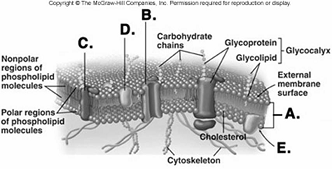 223. What structure does "A" represent on the diagram of
the plasma membrane? | back 162 B |
front 163 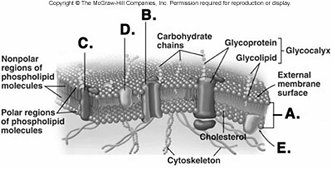 224. What structure does "B" represent on the diagram of
the plasma membrane? | back 163 A |
front 164 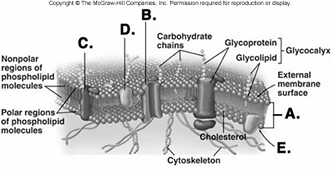 225. What structure does "C" represent on the diagram of
the plasma membrane? | back 164 C |
front 165 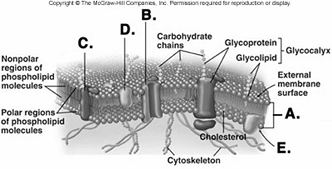 226. What structure does "D" represent on the diagram of
the plasma membrane? | back 165 D |
front 166 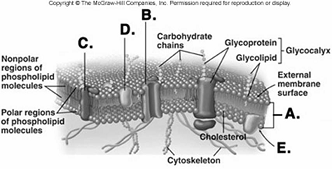 227. What structure does "E" represent on the diagram of
the plasma membrane? | back 166 C |
front 167 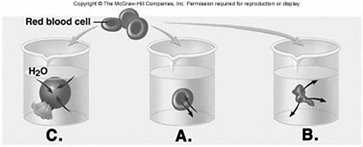 228. Red blood cells (RBCs) have been placed in three different
solutions: hypotonic, hypertonic, isotonic. What is solution
"A" relative to the RBC? | back 167 C |
front 168 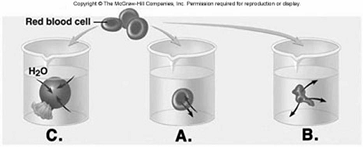 229. Red blood cells (RBCs) have been placed in three different
solutions: hypotonic, hypertonic, isotonic. What is solution
"B" relative to the RBC? | back 168 B |
front 169 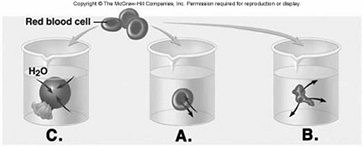 230. Red blood cells (RBCs) have been placed in three different
solutions: hypotonic, hypertonic, isotonic. What is solution
"C" relative to the RBC? | back 169 A |
front 170  231. Red blood cells (RBCs) have been placed in three different
solutions: hypotonic, hypertonic, isotonic. What is the condition of
the RBC in solution "C"? | back 170 D |
front 171 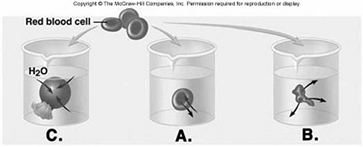 232. Red blood cells (RBCs) have been placed in three different
solutions: hypotonic, hypertonic, isotonic. What is the condition of
the RBC in solution "B"? | back 171 E |
front 172 60. A particular membrane transport process exhibits saturation, uses
carrier molecules, but does NOT require ATP. The process is probably
| back 172 B |
front 173 45. The aroma of cookies baking in the kitchen reaches you in the
living room. The distribution of this odor throughout the house is an
example of | back 173 E |
front 174 46. In the process of diffusion, net movement of substances is always
from a region | back 174 D |
front 175 47. Which of the following will increase the rate of diffusion?
| back 175 B |
front 176 48. Salt was added to a beaker of distilled water (the water was not
stirred). A sample taken from the bottom of the beaker was found to be
20% salt. At the same time, a sample taken from the top of the beaker
was found to be 2% salt. After 24 hours | back 176 B |
front 177 50. Osmosis is the diffusion of _____ across a selectively permeable
membrane. | back 177 C |
front 178 51. Solution A contains 5 grams of sugar per liter while solution B
contains 2 grams of sugar per liter. The solutions are separated by a
selectively permeable membrane. If the solvent in both solutions is
water, predict in which direction most of the water molecules will
move. | back 178 B |
front 179 53. A red blood cell that is placed in a hypertonic solution A. loses water. | back 179 A |
front 180 54. If 0.9% NaCl (saline) solution is isotonic to a cell, then a 0.5%
saline solution | back 180 C |
front 181 55. If a 0.9% NaCl (saline) solution is isotonic to a cell, then a
solution of 3.5% NaCl would be | back 181 A |
front 182 61. Which of the following are consistent with facilitated diffusion?
| back 182 B |
front 183 62. Which of the following would increase the maximum rate of
facilitated diffusion? | back 183 E |
front 184 63. Active transport | back 184 E |
front 185 64. Which of the following is NOT consistent with active transport?
| back 185 B |
front 186 65. Cyanide stops the production of ATP. Which of the following
processes would be affected? | back 186 C |
front 187 66. The sodium-potassium pump located in the plasma membrane | back 187 A |
front 188 67. Which of the following events occurs in the secondary active
transport of glucose? | back 188 E |
front 189 68. Certain cells in the liver ingest bacteria and debris from
damaged cells by a process called | back 189 B |
front 190 69. Pinocytosis | back 190 B |
front 191 70. Endocytosis | back 191 C |
front 192 71. White blood cells engulf foreign particles by means of | back 192 D |
front 193 72. All of the following processes can move substances out of a cell
EXCEPT | back 193 D |
front 194 73. Arrange the following events of exocytosis in the correct
sequence: | back 194 D |
front 195 74. Receptor-mediated endocytosis | back 195 B |
front 196 75. Which transport process requires a carrier molecule but does not
use cellular energy? | back 196 D |
front 197 76. The bulk uptake of material by the formation of a vesicle is
called | back 197 C |
front 198 77. The movement of a substance from an area of high concentration to
an area of less concentration is called | back 198 B |
front 199 78. The movement of water through a selectively permeable membrane is
called | back 199 E |
front 200 79. The movement of molecules against their concentration gradient is
called | back 200 A |
front 201 144. What is a large, active phagocytic cell? | back 201 E |
front 202 96. If a toxic drug inhibited mRNA synthesis, which of the following
would be most directly affected? | back 202 A |
front 203 80. Cytoplasm is found | back 203 B |
front 204 81. The cytoplasm is made up of | back 204 D |
front 205 83. The cytoskeleton consists of | back 205 D |
front 206 85. Microtubules | back 206 C |
front 207 84. Absence of a cytoskeleton might affect | back 207 A |
front 208 86. Of the organelles listed, which one does NOT contain
microtubules? | back 208 D |
front 209 126. Which of the following cell organelles does not contain
microtubules? | back 209 E |
front 210 151. Messenger RNA | back 210 A |
front 211 152. The transfer of information from DNA to messenger RNA (mRNA) is
known as | back 211 D |
front 212 153. Which of the following sequences is correct? | back 212 B |
front 213 155. Transcription | back 213 B |
front 214 157. Posttranscriptional processing is the modification of | back 214 C |
front 215 161. If a mRNA molecule is 1800 nucleotides (bases) in length, this
molecule will contain _____ codons. | back 215 B |
front 216 163. Translation | back 216 B |
front 217 167. Which of the following is NOT posttranslational processing?
| back 217 D |
front 218 169. A mRNA containing introns is a | back 218 A |
front 219 43. Which of the following statements concerning membrane transport
across the plasma membrane is true? | back 219 B |
front 220 Proteins of the plasma membrane serve all of the following functions,
except | back 220 A |
front 221 Transport protein specificity means that the protein | back 221 A |
front 222 Channel proteins | back 222 D |
front 223 Cadherins are | back 223 C |
front 224 Which of the following is CORRECTLY matched with its function? | back 224 C |
front 225 The passive movement of an ion or molecule across a plasma membrane
with the aid of a carrier protein is | back 225 C |
front 226 Many gland cells release their secretions by means of _______, a
process somewhat like reverse endocytosis. | back 226 A |
front 227 The greater the concentration of a solute in a solution, the greater
the | back 227 B |
front 228 What characteristic is shared by simple diffusion and facilitated
diffusion? | back 228 D |
front 229 In simple diffusion, the rate at which a solute passes through a
membrane depends on all of the following EXCEPT the | back 229 B |
front 230 When molecules move from the area of lower concentration to the area
of higher concentration and energy is used, it is called | back 230 C |
front 231 What change/s occur when red blood cells are placed in a hypertonic
solution? | back 231 B |
front 232 0.9% NaCl solution (saline) is isotonic to a cell, while seawater
is | back 232 A |
front 233 What organelle is most active in digesting endocytosed
materials? | back 233 A |
front 234 Organelles outside of the nucleus of cell are surrounded by a fluid
called the | back 234 C |
front 235 Which of the following organelles have their structure and function
accurately described? | back 235 D |
front 236 The microtubule organizing center of a cell is the | back 236 C |
front 237 Intermediate filaments are found in the | back 237 C |
front 238 An mRNA molecule of 2400 nucleotides (bases) in length, could contain
_______ codons. | back 238 A |